Abstract
Respiring liver mitochondria were allowed to export Ca2+ on the endogenous Ca2+/nH+ antiporter in the presence of Ruthenium Red (to inhibit uptake on the Ca2+ uniporter) until a steady state was reached. Addition of sufficient of the ionophore A23187 (which catalyses Ca2+/2H+ exchange) to bring the Ca2+ and H+ gradients into equilibrium did not alter the steady state. Thermodynamic analysis showed that if a Ca2+/nH+ exchange with any value of n other than 2 was at equilibrium, addition of A23187 would have caused an easily measurable change in extramitochondrial free [Ca2+]. Therefore, the endogenous carrier of liver mitochondria catalyses electroneutral Ca2+/2H+ antiport.
Full text
PDF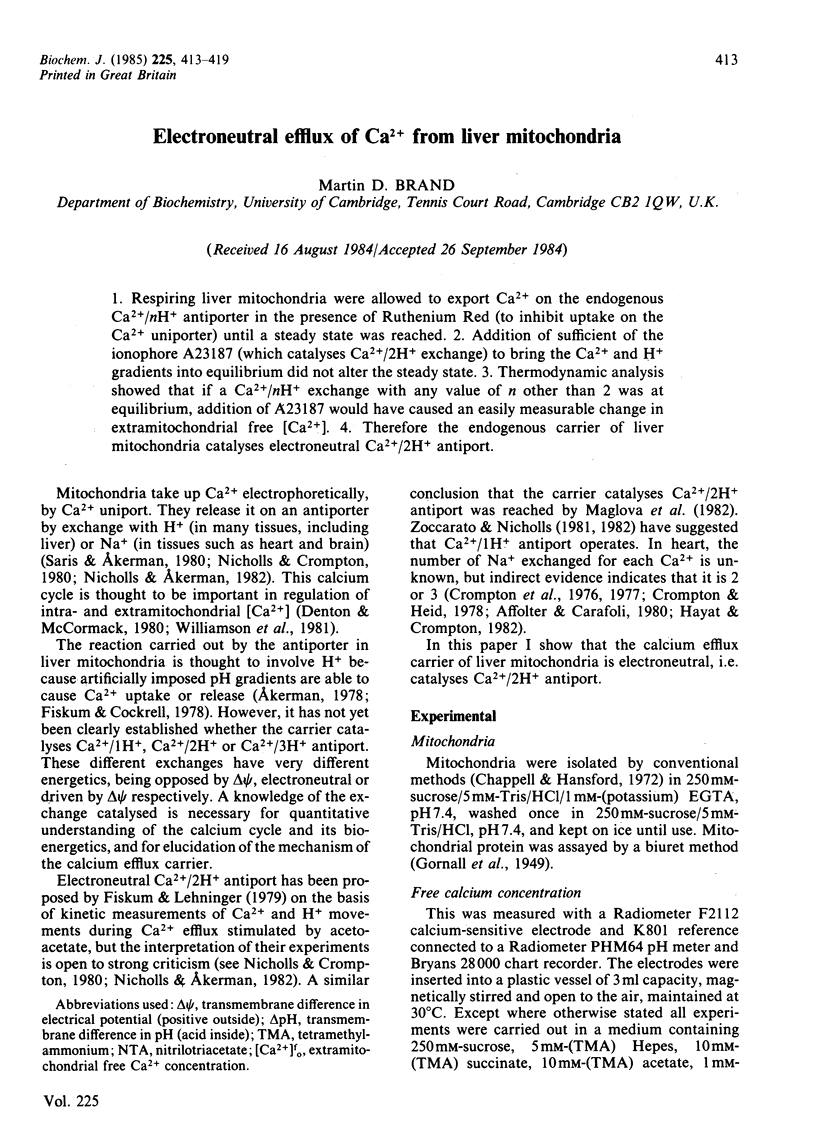
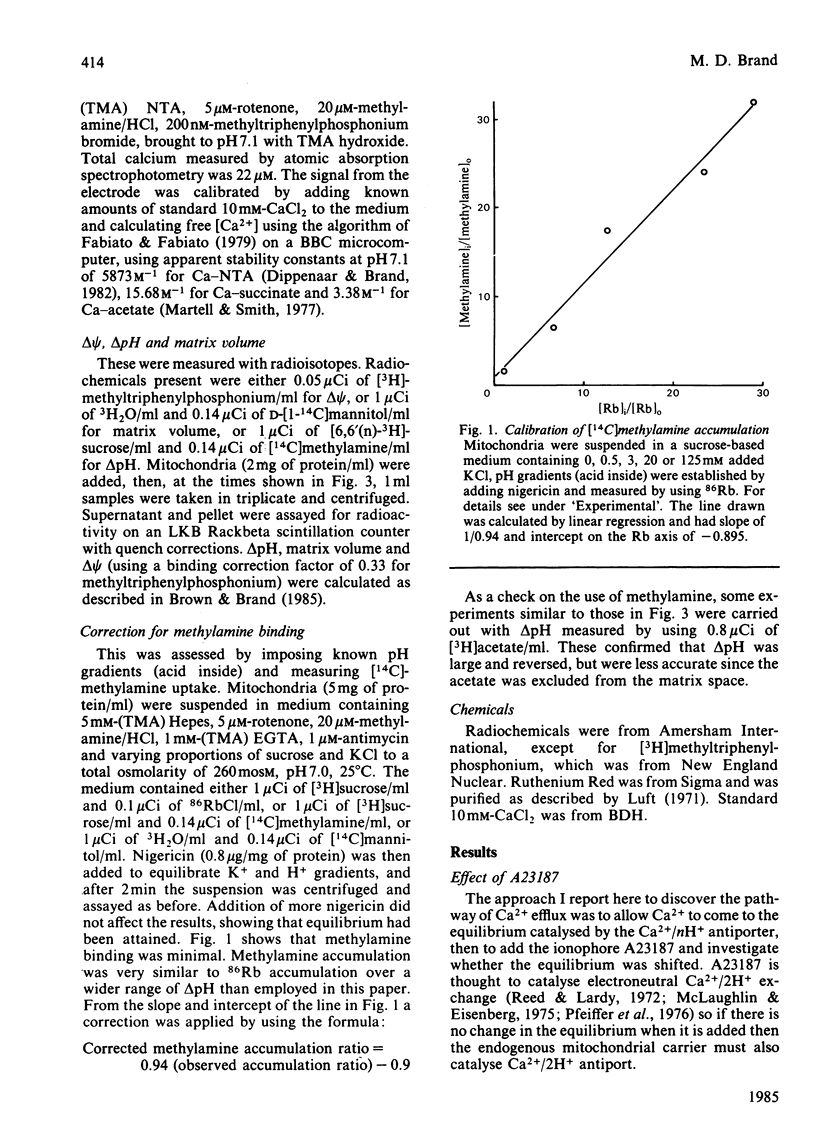
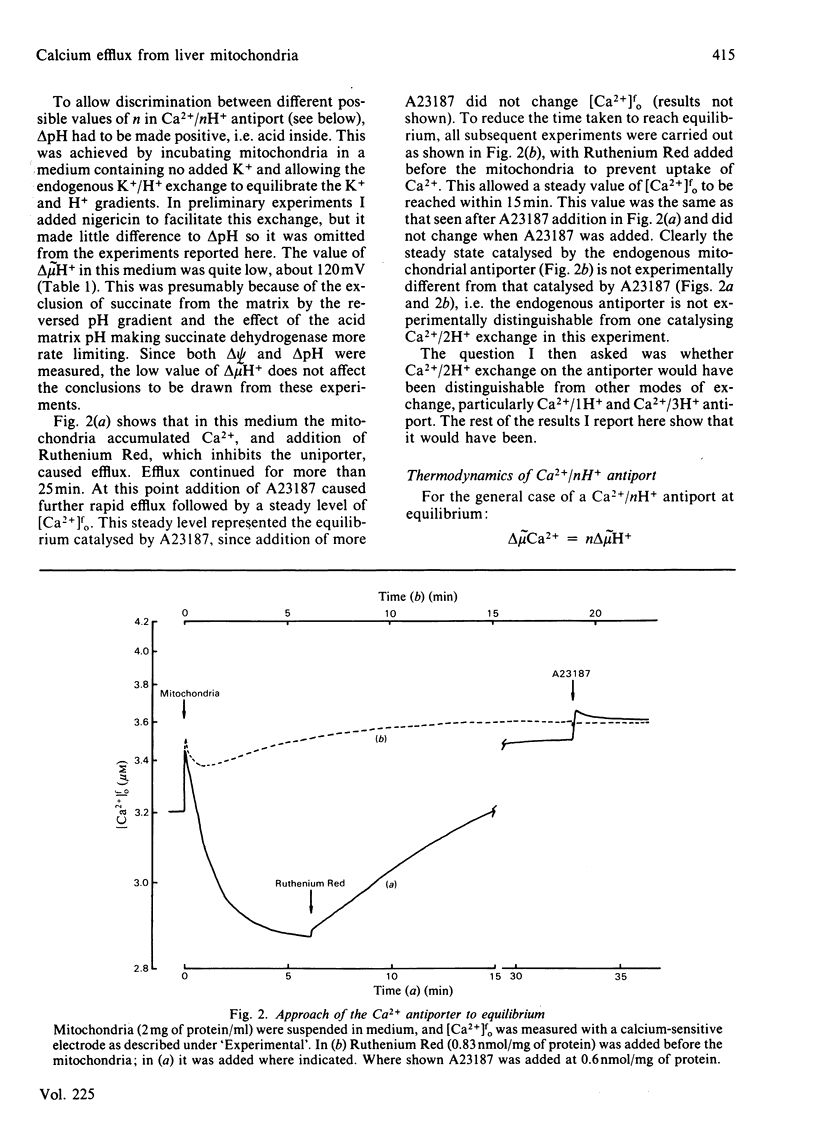
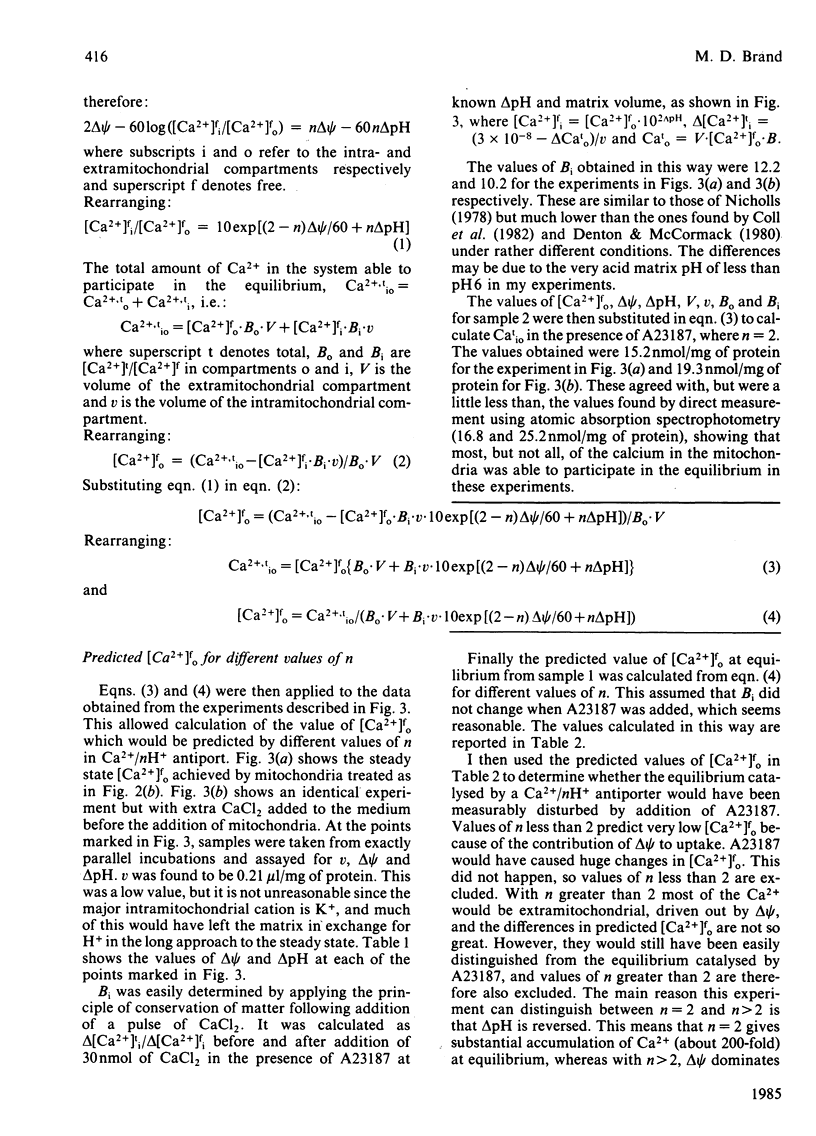
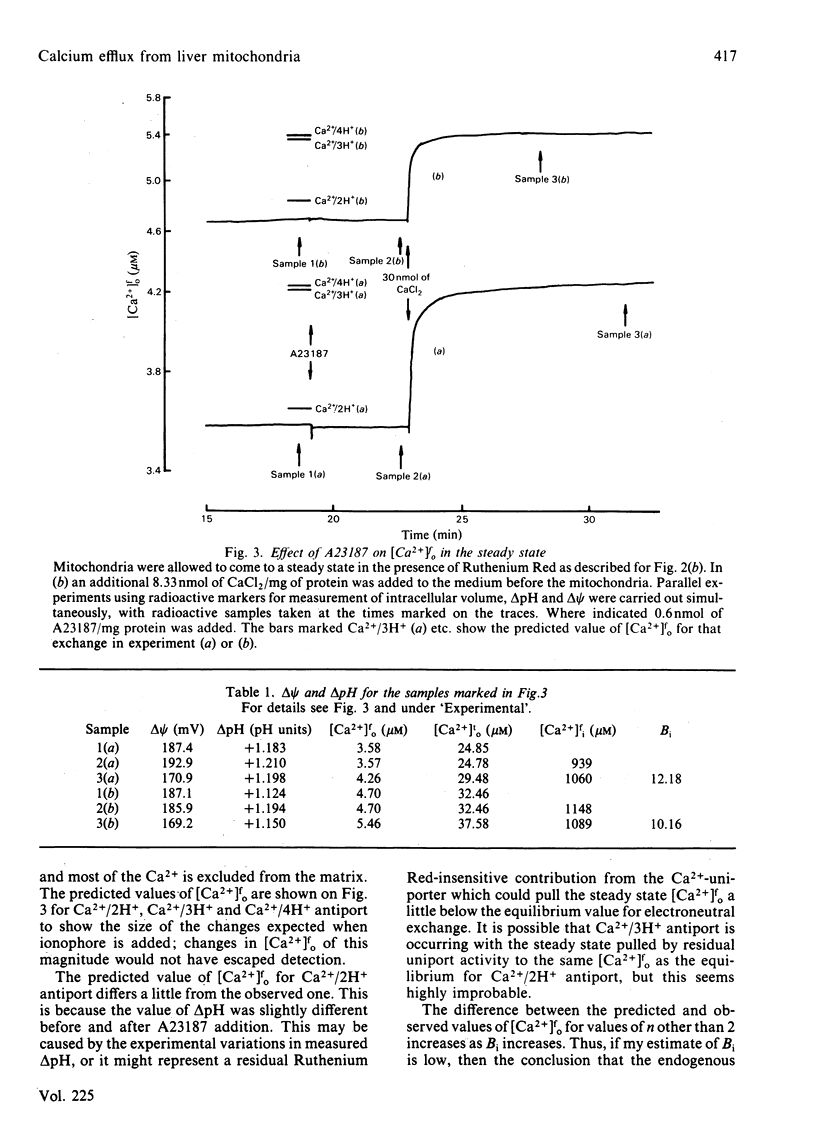
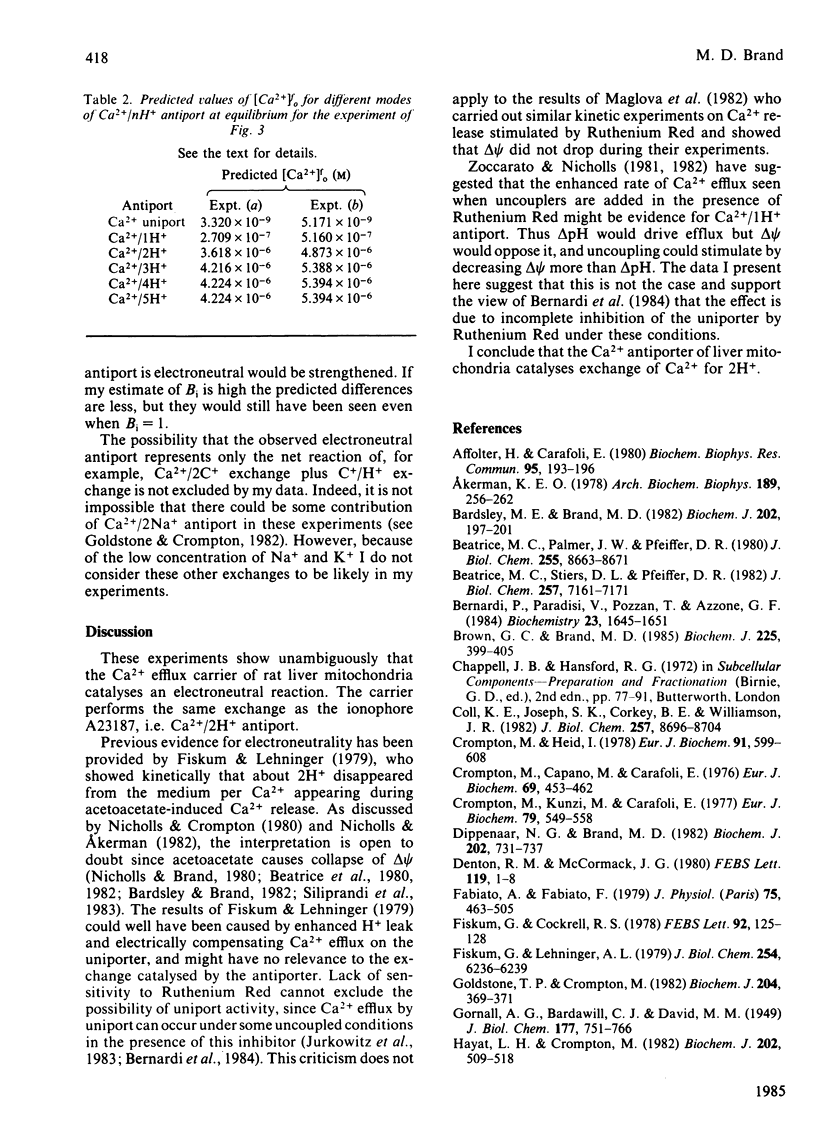
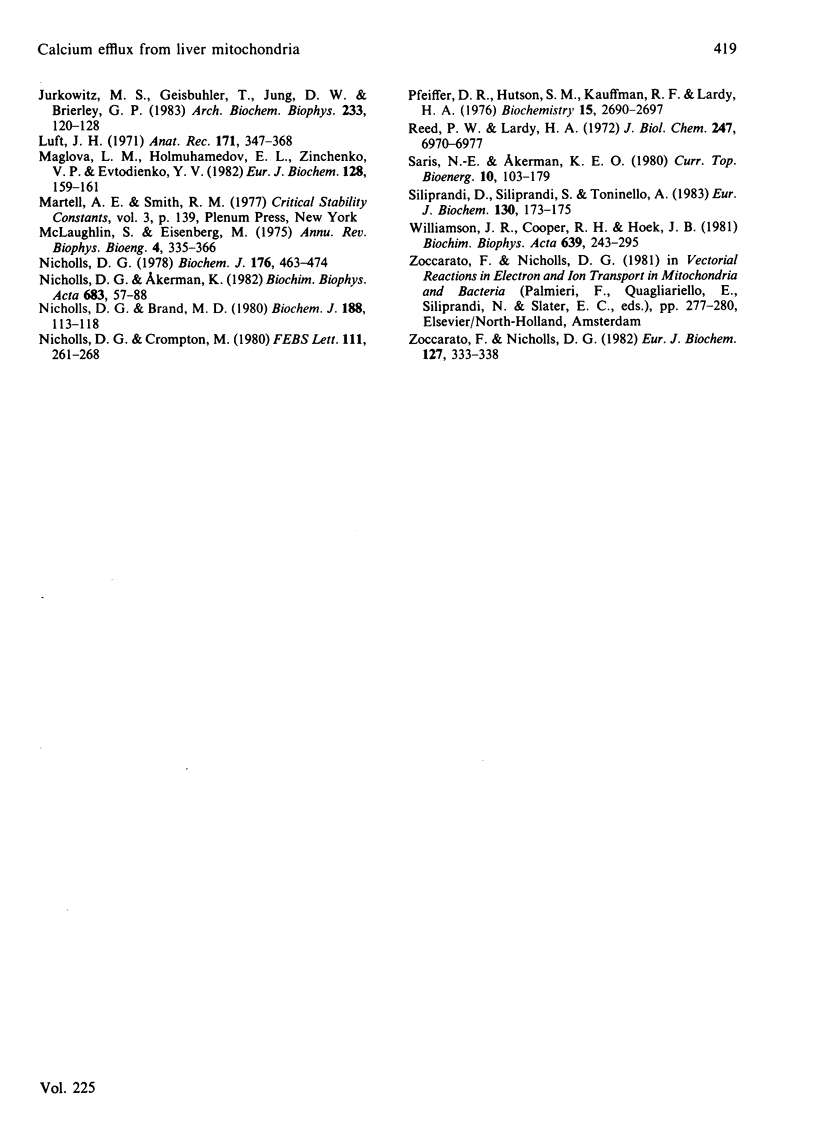
Selected References
These references are in PubMed. This may not be the complete list of references from this article.
- Affolter H., Carafoli E. The Ca2+-Na+ antiporter of heart mitochondria operates electroneutrally. Biochem Biophys Res Commun. 1980 Jul 16;95(1):193–196. doi: 10.1016/0006-291x(80)90723-8. [DOI] [PubMed] [Google Scholar]
- Akerman K. E. Effect of pH and Ca2+ on the retention of Ca2+ by rat liver mitochondria. Arch Biochem Biophys. 1978 Aug;189(2):256–262. doi: 10.1016/0003-9861(78)90211-4. [DOI] [PubMed] [Google Scholar]
- Bardsley M. E., Brand M. D. Oxaloacetate- and acetoacetate-induced calcium efflux from mitochondria occurs by reversal of the uptake pathway. Biochem J. 1982 Jan 15;202(1):197–201. doi: 10.1042/bj2020197. [DOI] [PMC free article] [PubMed] [Google Scholar]
- Beatrice M. C., Palmer J. W., Pfeiffer D. R. The relationship between mitochondrial membrane permeability, membrane potential, and the retention of Ca2+ by mitochondria. J Biol Chem. 1980 Sep 25;255(18):8663–8671. [PubMed] [Google Scholar]
- Beatrice M. C., Stiers D. L., Pfeiffer D. R. Increased permeability of mitochondria during Ca2+ release induced by t-butyl hydroperoxide or oxalacetate. the effect of ruthenium red. J Biol Chem. 1982 Jun 25;257(12):7161–7171. [PubMed] [Google Scholar]
- Bernardi P., Paradisi V., Pozzan T., Azzone G. F. Pathway for uncoupler-induced calcium efflux in rat liver mitochondria: inhibition by ruthenium red. Biochemistry. 1984 Apr 10;23(8):1645–1651. doi: 10.1021/bi00303a010. [DOI] [PubMed] [Google Scholar]
- Brown G. C., Brand M. D. Thermodynamic control of electron flux through mitochondrial cytochrome bc1 complex. Biochem J. 1985 Jan 15;225(2):399–405. doi: 10.1042/bj2250399. [DOI] [PMC free article] [PubMed] [Google Scholar]
- Coll K. E., Joseph S. K., Corkey B. E., Williamson J. R. Determination of the matrix free Ca2+ concentration and kinetics of Ca2+ efflux in liver and heart mitochondria. J Biol Chem. 1982 Aug 10;257(15):8696–8704. [PubMed] [Google Scholar]
- Crompton M., Heid I. The cycling of calcium, sodium, and protons across the inner membrane of cardiac mitochondria. Eur J Biochem. 1978 Nov 15;91(2):599–608. doi: 10.1111/j.1432-1033.1978.tb12713.x. [DOI] [PubMed] [Google Scholar]
- Crompton M., Künzi M., Carafoli E. The calcium-induced and sodium-induced effluxes of calcium from heart mitochondria. Evidence for a sodium-calcium carrier. Eur J Biochem. 1977 Oct 3;79(2):549–558. doi: 10.1111/j.1432-1033.1977.tb11839.x. [DOI] [PubMed] [Google Scholar]
- Denton R. M., McCormack J. G. On the role of the calcium transport cycle in heart and other mammalian mitochondria. FEBS Lett. 1980 Sep 22;119(1):1–8. doi: 10.1016/0014-5793(80)80986-0. [DOI] [PubMed] [Google Scholar]
- Dippenaar N. G., Brand M. D. The isolation of lymphocyte mitochondria and their regulation of extramitochondrial free Ca2+ concentration. Biochem J. 1982 Mar 15;202(3):731–737. doi: 10.1042/bj2020731. [DOI] [PMC free article] [PubMed] [Google Scholar]
- Fabiato A., Fabiato F. Calculator programs for computing the composition of the solutions containing multiple metals and ligands used for experiments in skinned muscle cells. J Physiol (Paris) 1979;75(5):463–505. [PubMed] [Google Scholar]
- Fiskum G., Cockrell R. S. Ruthenium red sensitive and insensitive calcium transport in rat liver and Ehrlich ascites tumor cell mitochondria. FEBS Lett. 1978 Aug 1;92(1):125–128. doi: 10.1016/0014-5793(78)80736-4. [DOI] [PubMed] [Google Scholar]
- Fiskum G., Lehninger A. L. Regulated release of Ca2+ from respiring mitochondria by Ca2+/2H+ antiport. J Biol Chem. 1979 Jul 25;254(14):6236–6239. [PubMed] [Google Scholar]
- Goldstone T. P., Crompton M. Evidence for beta-adrenergic activation of Na+-dependent efflux of Ca2+ from isolated liver mitochondria. Biochem J. 1982 Apr 15;204(1):369–371. doi: 10.1042/bj2040369. [DOI] [PMC free article] [PubMed] [Google Scholar]
- Hayat L. H., Crompton M. Evidence for the existence of regulatory sites for Ca2+ on the Na+/Ca2+ carrier of cardiac mitochondria. Biochem J. 1982 Feb 15;202(2):509–518. doi: 10.1042/bj2020509. [DOI] [PMC free article] [PubMed] [Google Scholar]
- Jurkowitz M. S., Geisbuhler T., Jung D. W., Brierley G. P. Ruthenium red-sensitive and -insensitive release of Ca2+ from uncoupled heart mitochondria. Arch Biochem Biophys. 1983 May;223(1):120–128. doi: 10.1016/0003-9861(83)90577-5. [DOI] [PubMed] [Google Scholar]
- Luft J. H. Ruthenium red and violet. I. Chemistry, purification, methods of use for electron microscopy and mechanism of action. Anat Rec. 1971 Nov;171(3):347–368. doi: 10.1002/ar.1091710302. [DOI] [PubMed] [Google Scholar]
- Maglova L. M., Holmuhamedov E. L., Zinchenko V. P., Evtodienko Y. V. Induction of 2H+/Me2+ exchange in rat-liver mitochondria. Eur J Biochem. 1982 Nov;128(1):159–161. doi: 10.1111/j.1432-1033.1982.tb06946.x. [DOI] [PubMed] [Google Scholar]
- McLaughlin S., Eisenberg M. Antibiotics and membrane biology. Annu Rev Biophys Bioeng. 1975;4(00):335–366. doi: 10.1146/annurev.bb.04.060175.002003. [DOI] [PubMed] [Google Scholar]
- Nicholls D. G., Brand M. D. The nature of the calcium ion efflux induced in rat liver mitochondria by the oxidation of endogenous nicotinamide nucleotides. Biochem J. 1980 Apr 15;188(1):113–118. doi: 10.1042/bj1880113. [DOI] [PMC free article] [PubMed] [Google Scholar]
- Nicholls D. G., Crompton M. Mitochondrial calcium transport. FEBS Lett. 1980 Mar 10;111(2):261–268. doi: 10.1016/0014-5793(80)80806-4. [DOI] [PubMed] [Google Scholar]
- Nicholls D. G. The regulation of extramitochondrial free calcium ion concentration by rat liver mitochondria. Biochem J. 1978 Nov 15;176(2):463–474. doi: 10.1042/bj1760463. [DOI] [PMC free article] [PubMed] [Google Scholar]
- Nicholls D., Akerman K. Mitochondrial calcium transport. Biochim Biophys Acta. 1982 Sep 1;683(1):57–88. doi: 10.1016/0304-4173(82)90013-1. [DOI] [PubMed] [Google Scholar]
- Pfeiffer D. R., Hutson S. M., Kauffman R. F., Lardy H. A. Some effects of ionophore A23187 on energy utilization and the distribution of cations and anions in mitochondria. Biochemistry. 1976 Jun 15;15(12):2690–2697. doi: 10.1021/bi00657a032. [DOI] [PubMed] [Google Scholar]
- Reed P. W., Lardy H. A. A23187: a divalent cation ionophore. J Biol Chem. 1972 Nov 10;247(21):6970–6977. [PubMed] [Google Scholar]
- Siliprandi D., Siliprandi N., Toninello A. On the relationship between calcium and phosphate transport, transmembrane potential and acetoacetate-induced oxidation of pyridine nucleotides in rat-liver mitochondria. Eur J Biochem. 1983 Jan 17;130(1):173–175. doi: 10.1111/j.1432-1033.1983.tb07133.x. [DOI] [PubMed] [Google Scholar]
- Williamson J. R., Cooper R. H., Hoek J. B. Role of calcium in the hormonal regulation of liver metabolism. Biochim Biophys Acta. 1981 Dec 30;639(3-4):243–295. doi: 10.1016/0304-4173(81)90012-4. [DOI] [PubMed] [Google Scholar]
- Zoccarato F., Nicholls D. The role of phosphate in the regulation of the independent calcium-efflux pathway of liver mitochondria. Eur J Biochem. 1982 Oct;127(2):333–338. doi: 10.1111/j.1432-1033.1982.tb06875.x. [DOI] [PubMed] [Google Scholar]


